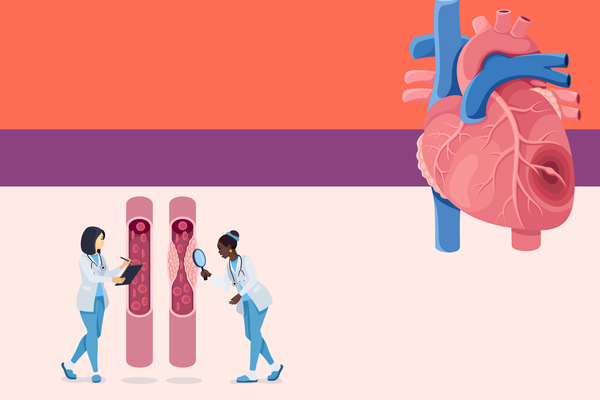1. Being a woman does not let you off the hook for heart disease.
You may think that because you are a woman, you don't have to worry about heart disease because heart disease is a man's disease. WRONG! Heart disease is an equal opportunity killer. It's true that women have fewer heart attacks than men before they reach menopause, but after that women quickly catch up with men. Every year more than 500,000 women die of cardiovascular diseases, according to the American Heart Association.
2. You're in the driver's seat when it comes to controlling many of the risk factors for heart disease.
There are certain risk factors for heart disease that you can't control, like having a family history of coronary heart disease, your age (the risk of heart disease increases with age), or your race and ethnicity (African Americans, Mexican Americans, American Indians, and other Native Americans are at greater risk than whites for heart disease). Though these are factors you can't control, there are plenty other conditions and behaviors related to your lifestyle that you can control to lessen your risk of heart disease. The more of those you can get a grip on, the better your odds.
3. If you smoke, you're doing your heart no favors.
If you're a woman and a smoker, you are two to six times more likely to develop heart disease than if you are a nonsmoker. Your risk increases with the number of cigarettes smoked per day. Being around other people's smoke isn't healthy for your heart either; it increases your risk of heart disease even if you're a nonsmoker.
The good news is that kicking butt, as in quitting smoking, dramatically cuts the risk to your heart, even during the first year, no matter what your age.
4. Your weight, especially the size of your waistline, matters.
Too much body fat, especially around your middle, increases your risk of heart disease and other serious diseases and conditions as well, including high blood pressure and diabetes. "Apple-shaped" women with extra fat at the waistline may have a higher risk than "pear-shaped" women with heavy hips and thighs. If your waist is nearly as large as, or larger than, the size of your hips, you may have a higher risk for coronary heart disease.
5. Couch potato alert! Physical inactivity increases your risk of heart disease.
Belly dancing, shooting hoops, swimming, walking your dog, gardening-- whatever physical activity you enjoy, DO IT! Your heart will thank you.
Federal exercise guidelines now recommend at least 150 minutes of moderate intensity or 75 minutes of vigorous intensity aerobic exercise per week. For maximum health benefits, the recommendation is 300 minutes of moderate intensity or 75 to 150 minutes of vigorous intensity aerobic physical activity per week. If 30 to 60 minutes sounds like too much to do at a stretch, take the 10 approach. Be creative and grab an extra 10 minutes of physical activity wherever you can throughout your day.
6. High blood pressure also puts you at risk for heart disease.
Even slightly elevated blood pressure levels can double your risk for heart disease.
If you have mild high blood pressure ("hypertension" is the medical term), you may be able to lower your blood pressure by reducing salt (sodium) in your diet, decreasing fat intake, eating lots of fruits and vegetables, switching to low-fat dairy products, and cutting back on alcohol, if you drink. If you are overweight, losing weight may reduce your blood pressure too. In some cases, these changes won't be enough, and you may need a pharmacological boost. Remember, if you fall in this category, it's still important to eat a healthy diet and exercise.
7. High blood cholesterol is another risk factor you need to watch.
High blood cholesterol isn't just a problem that begins in middle age. It can start much, much earlier. You should have your blood cholesterol checked beginning at age 20 and have the test repeated at least every five years.
Lowering your blood cholesterol through exercise, diet and, if necessary, medication as well, can have a big payoff for your heart's health.
8. Be aware of diabetes.
Diabetes, or high blood sugar, is a serious disorder that also raises a woman's risk of heart disease enormously. Nearly 70 percent of women with diabetes die of some type of cardiovascular disease.
You can lower your risk by keeping your blood sugar as close to normal as possible. Prediabetes is a condition that millions of Americans have. It's not full-blown diabetes but it can develop into it. Exercising, losing weight, and, if necessary, taking medication can protect you.
9. Stress—and your response to it—might break your heart, too.
While stress is not considered an illness, it can cause specific medical symptoms, some serious enough to send women to the emergency room or their health care professional's office. Women who have too much stress or an unhealthy response to stress may be at greater risk for heart disease.
The good news is that sensible health habits can have a protective effect. Regular physical activity not only relieves stress, but also can directly lower your risk of heart disease.
10. If you take hormone therapy (HRT) for the treatment of menopause, your risk of heart attack and stroke could increase.
Some women, but not all, who take hormone replacement therapy for the treatment of menopause may have increased risk of blood clots, heart attack and stroke. You need to discuss your individual risk with your health care professional.




